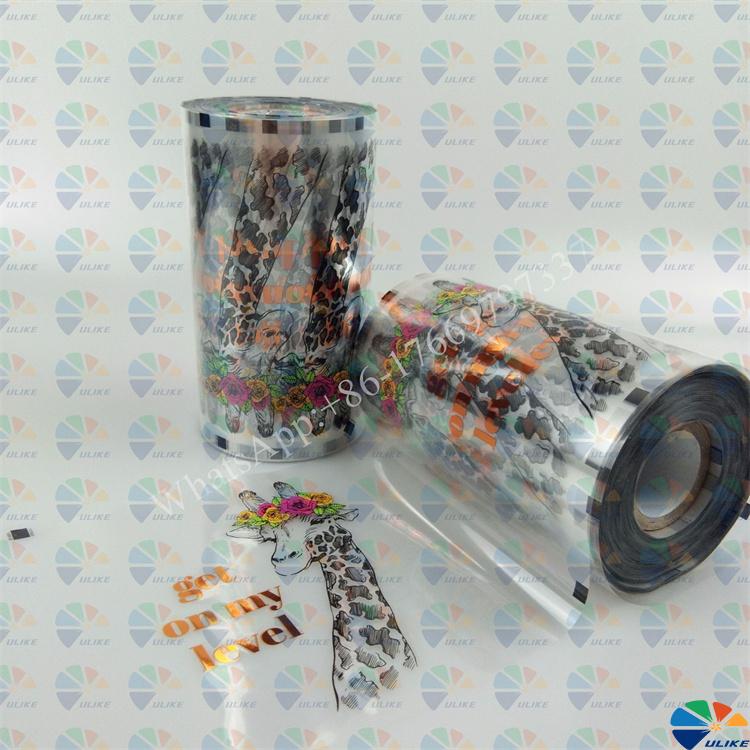What is metal hot stamping film?
1What is metal
hot stamping film?
People who have contact with printing must be familiar with hot stamping film. Hot stamping film can generally be used on a variety of products, such as product packaging, greeting cards, cosmetics, household appliances, automotive interior and exterior decoration, etc. Hot stamping film can be divided into many types according to its properties, among which metal hot stamping film is more special. Today we will learn about metal hot stamping film in detail.
Metal hot stamping film, also known as aluminized film, is a hot stamping material made by vacuum evaporating a layer of metal on a film base. It can generally be divided into 5 conventional process flows, and its production process is as follows:
2 Base film layer
The base film layer is also called the base layer or carrier, which supports other layers. Its thickness can be divided into 12 wires, 16 wires, 18 wires, 20 wires, and 25 wires. Generally, a 20-wire thick PET film is often used. This type of PET film is resistant to high temperatures and can reach up to 170°C. It also has good unidirectional stretchability and is not easy to break when stretched.
3 Release layer
It is referred to as release layer. This layer can quickly separate the ink, aluminum layer and glue layer from the PET plastic film during hot stamping, so as to quickly transfer and bond to the surface of the substrate.
4 Ink layer
This layer provides a variety of color effects, protects the ink and aluminum layer at the same time, and can enhance the brightness of the hot stamping paper after hot stamping. It is mainly composed of a variety of synthetic resins and dyes to form colorful colors, such as red, green, yellow, blue, purple...
5 Metal layer
The metal layer is also called the aluminum layer. It is formed by vacuum high-temperature evaporation, cooling, sublimation and precipitation of metal. The post-printing effect has a metallic feel, which improves the grade of the product.
6 Glue layer
It is mainly composed of hot-melt plastic or resin. Its function is to bond the aluminum layer and ink layer to the surface of the substrate under the action of pressure and temperature.
![af]() Afrikaans
Afrikaans![sq]() Albanian
Albanian![am]() Amharic
Amharic![ar]() Arabic
Arabic![fr]() French
French![es]() Spanish
Spanish![ru]() Russian
Russian![de]() German
German![hy]() Armenian
Armenian![it]() Italian
Italian![ja]() Japanese
Japanese![ko]() Korean
Korean![pt]() Portuguese
Portuguese![hi]() Hindi
Hindi![az]() Azerbaijani
Azerbaijani![ro]() Romanian
Romanian![pl]() Polish
Polish![th]() Thai
Thai![el]() Greek
Greek![eu]() Basque
Basque![en]() English
English![zh-CN]() Chinese (Simplified)
Chinese (Simplified)![zh-TW]() Chinese (Traditional)
Chinese (Traditional)![be]() Belarusian
Belarusian![bn]() Bengali
Bengali![bs]() Bosnian
Bosnian![bg]() Bulgarian
Bulgarian![ca]() Catalan
Catalan![ceb]() Cebuano
Cebuano![ny]() Chichewa
Chichewa![co]() Corsican
Corsican![hr]() Croatian
Croatian![cs]() Czech
Czech![da]() Danish
Danish![nl]() Dutch
Dutch![eo]() Esperanto
Esperanto![et]() Estonian
Estonian![tl]() Filipino
Filipino![fi]() Finnish
Finnish![fy]() Frisian
Frisian![gl]() Galician
Galician![ka]() Georgian
Georgian![gu]() Gujarati
Gujarati![ht]() Haitian Creole
Haitian Creole![ha]() Hausa
Hausa![haw]() Hawaiian
Hawaiian![iw]() Hebrew
Hebrew![hmn]() Hmong
Hmong![hu]() Hungarian
Hungarian![is]() Icelandic
Icelandic![ig]() Igbo
Igbo![id]() Indonesian
Indonesian![ga]() Irish
Irish![jw]() Javanese
Javanese![kn]() Kannada
Kannada![kk]() Kazakh
Kazakh![km]() Khmer
Khmer![ku]() Kurdish (Kurmanji)
Kurdish (Kurmanji)![ky]() Kyrgyz
Kyrgyz![lo]() Lao
Lao![la]() Latin
Latin![lv]() Latvian
Latvian![lt]() Lithuanian
Lithuanian![lb]() Luxembourgish
Luxembourgish![mk]() Macedonian
Macedonian![mg]() Malagasy
Malagasy![ms]() Malay
Malay![ml]() Malayalam
Malayalam![mt]() Maltese
Maltese![mi]() Maori
Maori![mr]() Marathi
Marathi![mn]() Mongolian
Mongolian![my]() Myanmar (Burmese)
Myanmar (Burmese)![ne]() Nepali
Nepali![no]() Norwegian
Norwegian![ps]() Pashto
Pashto![fa]() Persian
Persian![pa]() Punjabi
Punjabi![sm]() Samoan
Samoan![gd]() Scottish Gaelic
Scottish Gaelic![sr]() Serbian
Serbian![st]() Sesotho
Sesotho![sn]() Shona
Shona![sd]() Sindhi
Sindhi![si]() Sinhala
Sinhala![sk]() Slovak
Slovak![sl]() Slovenian
Slovenian![so]() Somali
Somali![su]() Sudanese
Sudanese![sw]() Swahili
Swahili![sv]() Swedish
Swedish![tg]() Tajik
Tajik![ta]() Tamil
Tamil![te]() Telugu
Telugu![tr]() Turkish
Turkish![uk]() Ukrainian
Ukrainian![ur]() Urdu
Urdu![uz]() Uzbek
Uzbek![vi]() Vietnamese
Vietnamese![cy]() Welsh
Welsh![xh]() Xhosa
Xhosa![yi]() Yiddish
Yiddish![yo]() Yoruba
Yoruba![zu]() Zulu
Zulu


